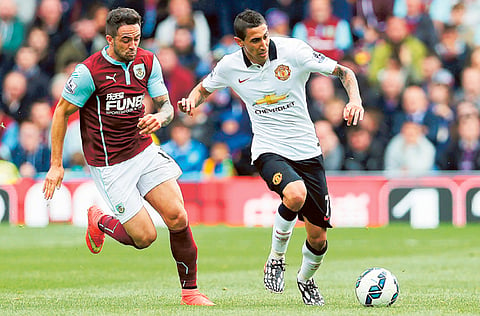Di Maria can provide United the swagger
Vulnerable 3-5-2 formation hindering Van Gaal’s team

London: When Angel di Maria left the pitch at the Stadium of Light in Lisbon after helping Real Madrid win the Champions League, he cannot have expected that when he first played for his next club he would be replaced by Anderson at Turf Moor.
Of all people, Anderson: the epitome of the overpaid, underachieving footballer and a player with no future at Manchester United. Di Maria, who was withdrawn as a precaution, having taken a kick to the calf, is very much part of United’s future, and was the only positive for the visitors from another anaemic display.
All the qualities associated with the United of the watching Sir Alex Ferguson were absent: there was no width, no swagger, no drive, no threat and little pace. If properly deployed, Di Maria could provide some of that. Far more of a left-sided force for Real against Atletico Madrid, Di Maria was brilliant in that May final.
Louis van Gaal used the £59.7 million (Dh364m) debut-maker more centrally here, leaving an overworked Darren Fletcher to do the ball-winning. Di Maria did not win one tackle in 69 minutes. For all Van Gaal’s post-match remarks about being a “smart coach”, and his CV undeniably gives substance to such self-regard, United’s new manager surely has to rethink his 3-5-2 system which spreads vulnerability from back to front.
Di Maria has stepped into a new team struggling to learn a new tactical language. Van Gaal spoke afterwards that Di Maria would need to “adapt to fellow players” and “them to him” but they are all adapting to a configuration that has rarely worked in English club football.
Even with Daley Blind shielding the back-three and Marcos Rojo eventually arriving after fighting through the red tape to get the red shirt, 3-5-2 is too porous and too susceptible to the pressing of all opponents in the Premier League who will not show respect, home or away.
Jonny Evans, a decent centre-half, looks particularly lost in the system. Di Maria is versatile enough to play centrally, as he showed box-to-box at Benfica, or tucked in to midfield in a 4-3-3 at Real. There was one exquisite long ball here through the middle that released Robin van Persie, but the Argentinian is at his best tormenting right-backs.
A frontline of Di Maria, Van Persie and the right-sided Adnan Januzaj, with Wayne Rooney in the hole, would have balance, penetration, pace and a cutting edge. United fans attempted to find positives, noting that the draw was one point more than on their last visit here five years ago, but really only Di Maria provided any cause to be upbeat.
His pace worried opponents, and his passing range was impressive, even if reaching only a 72.7 per cent pass completion here. It had been a day that mixed promise and frustration for Di Maria. The fifth most expensive footballer ever, a player who cost £15 million more than the total Burnley have spent since 1882, had been the last off the United bus with Juan Mata, walking past the knot of Burnley fans gathered in a corner of Turf Moor.
The most expensive purchase in Premier League history stepped from the small away dressing-room, squeezed through the throng in the tight corridor and out into the rain drifting in from Pendle Hill. He warmed up in front of the newly sponsored Totally Wicked Bob Lord Stand, spending time with Mata, before breaking away to work on his finishing.
As he neared the hoardings by the David Fishwick Stand, a couple of the 4,000 visiting fans leant over, waving a “United: One Love” banner. Their excitement about the Argentinian was understandable; their team needed an injection of pace and class. Yet Di Maria did not touch the ball for the first five minutes, at times looking surprised by the erratic nature of his new colleagues’ play.
United were wearing white shirts but this was far from the quality that Di Maria had been used to at Real. Early on, Di Maria signalled to Tyler Blackett to pass to Ashley Young and then watched bemused as the defender kicked the ball straight out. A long ball then disappeared over Di Maria’s head.
After all Van Gaal’s comments about Burnley playing “long ball”, revealing he had not sufficiently researched Sean Dyche’s side, it was United delivering the ball over distance, 50 times in the first half. Di Maria’s role looked a David Beckham dream: No. 7 on his back and a central role with few defensive duties.
He finally took his first pass, from Rooney, running 40 yards before over-hitting the return to his captain much to the delight of the Jimmy McIlroy Stand. “Argentina, Argentina” chanted the United fans in support of the man from Rosario. He then under-hit a ball towards Van Persie and Ben Mee intervened easily.
But then it came, after nine minutes, the first sign of Di Maria’s quality. Here was confirmation that United have someone with special qualities. Ten yards in his own half, Di Maria looked up, spotting Van Persie on the shoulder of the last defender, Michael Duff. Turning defence into attack with one touch, Di Maria swept the ball 50 yards, picking out Van Persie.
The Dutchman took the ball on his chest but was denied by Tom Heaton. And then it came again, more evidence of that talent that United have invested so handsomely in. Di Maria spun away from Kieran Trippier, receiving the return from Young, and crossing to Mata who fluffed a great opportunity. That ability to deliver from the left, a trait so memorably seen in Lisbon, was noted here.
Di Maria will have more memorable moments in a United shirt.
Sign up for the Daily Briefing
Get the latest news and updates straight to your inbox


